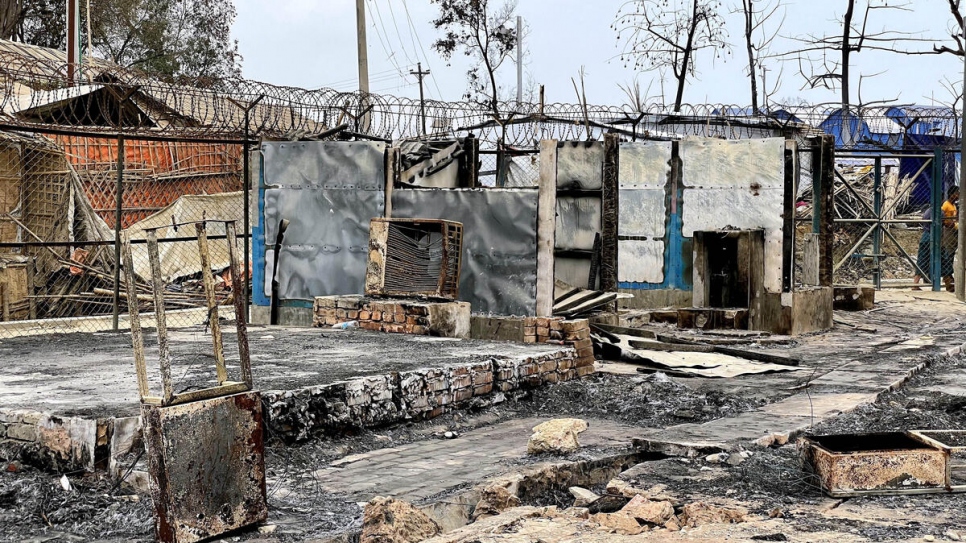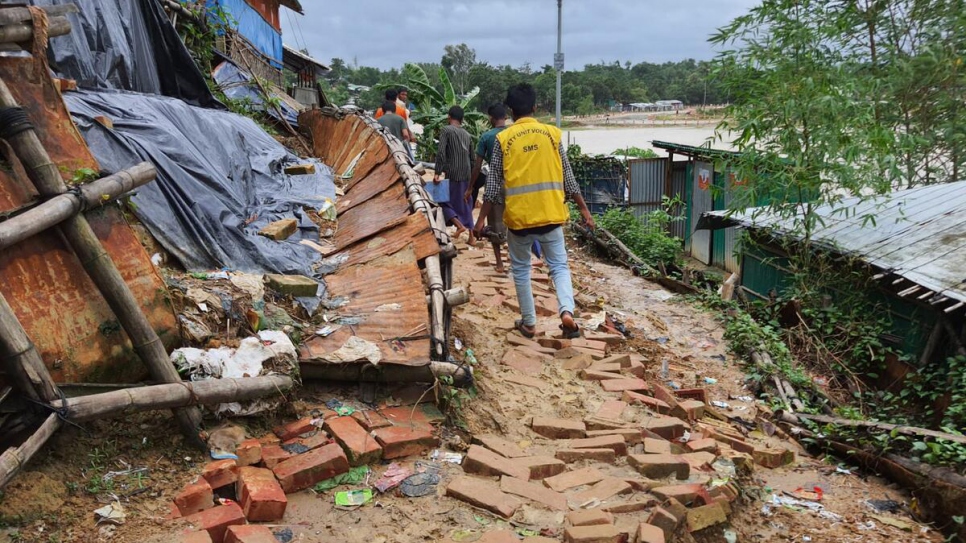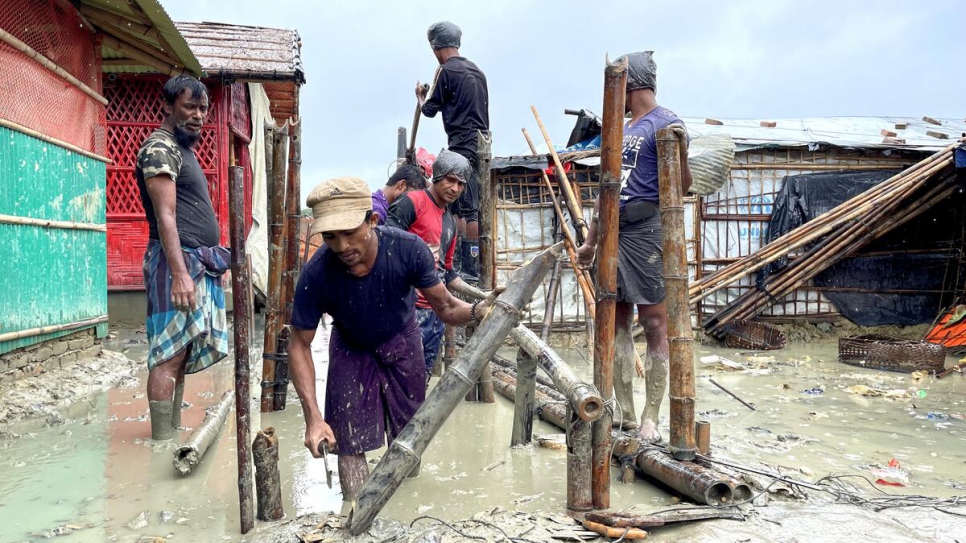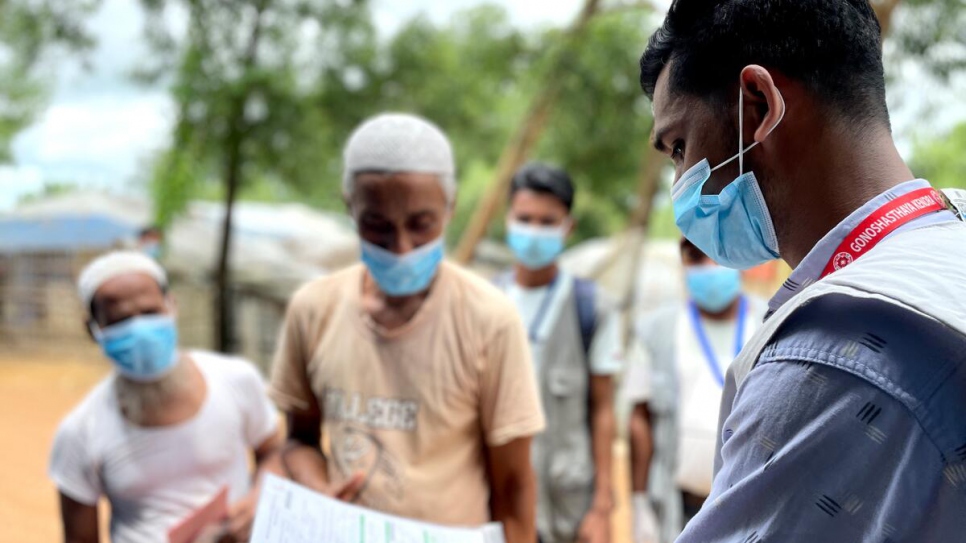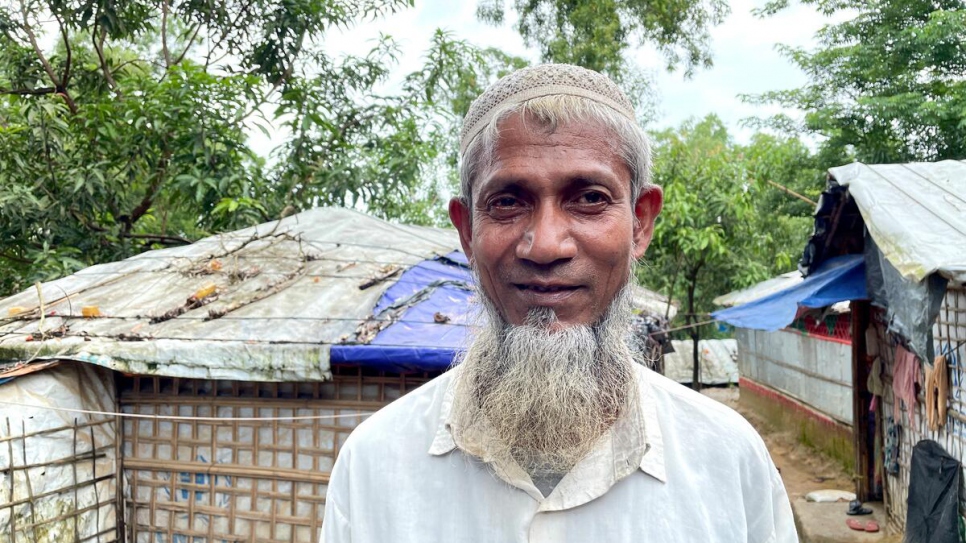Flooding, fires and COVID bring fresh challenges for Rohingya refugees in Bangladesh
The global pandemic, flooding and fires were just some of the hardships faced by Rohingya refugees over the past year.
Heavy monsoon rains in July and August triggered flooding and landslides at Rohingya refugee camps in Cox's Bazar.
© UNHCR/Amos Halder
Four years after fleeing to Bangladesh from Myanmar, Rohingya refugees may have just survived their most challenging year yet.
Life in the congested camps that are home to over 880,000 Rohingya refugees was already tough, but the COVID-19 pandemic has brought new hardships – limiting movements, closing learning centres and reducing on-site assistance provided by aid organizations.
Then came a massive fire in March that reduced nearly 10,000 shelters to ashes and killed 11 refugees. The fire was followed by a particularly wet monsoon season that brought more than 700mm of rain in just one week between 27 July and 3 August, inundating more than 400 local villages, washing away shelters and triggering flooding and landslides that killed some 20 people, 10 of which were refugees. Some 24,000 refugees were forced to abandon their homes and belongings.
"We are always scared of diseases and fire."
“Since we live in a congested situation, we are always scared of diseases and fire breaking out …and of our houses getting flooded,” said Asmida, 33, one of more than 7,000 refugee volunteers trained by the UN Refugee Agency, UNHCR, and partners to respond to emergencies such as fires and flooding.
During the monsoon season, she has helped pregnant women, children and elderly people from her block reach a safe place. She and the other volunteers have also worked tirelessly to help organize and coordinate the work of clearing away mud and repairing shelters, roads and bridges.
Rohingya refugee volunteers like Asmida, together with Bangladeshi workers from the surrounding communities in Cox’s Bazar District, form the backbone of delivery for humanitarian services in the camps, particularly over the past 18 months when COVID restrictions have reduced the presence of aid workers. They know the whereabouts of the most vulnerable people in their communities likely to need help in an emergency and keep an eye on the most flood-prone areas in the camps when the monsoon rains are particularly heavy.
Mohammad Aiyaz, another volunteer, was monitoring one such area last month when he heard children screaming.
“We saw that a boy was drowning in the canal,” he recalled. “I went close to him and tossed a throw bag to him. He caught it and we pulled him safely to the bank and handed him over to his parents.”
As well as acting as first responders in emergency situations, refugee volunteers, who include trained community health workers, have played a vital role during the COVID-19 pandemic – sharing life-saving messages on how to prevent infection, recognize symptoms and where to go for testing and treatment.
Recently they have been helping prepare the ground for the roll-out of COVID-19 vaccines following the decision by the Bangladeshi government to start offering them to older Rohingya refugees.
Humayun Kabir, a local Bangladeshi, supervises one of the groups of Rohingya community health workers who are working to ensure that as many older refugees as possible take up the offer of a vaccine.
“In the beginning, there was some fear and confusion regarding the vaccine,” he said. “We were successful to help them overcome [that] through messaging, leaflets and videos.”
The first round of vaccinations started on 10 August and over 34,000 refugees aged 55 and above have now received their first jab.
Among them was Nur Islam, 59. “In my lifetime of more than 50 years in Myanmar, I never received any vaccines,” he said. “After coming to Bangladesh, we got our first vaccines. We are six members in the family, among whom only I could be vaccinated so far.”
For those with disabilities or too frail to reach one of the 56 vaccination centres, the volunteers help to transport them from their shelters by carrying them or using homemade stretchers.
“If the Rohingyas are not safe, the Bangladeshis are not safe either,” Humayun pointed out. “That’s why vaccination for all is crucial.”
With a second phase of the vaccination rollout due to start in the coming months that is expected to reach more Rohingya refugees, there is some hope that restrictions in the camps will eventually be eased. But natural disasters and lack of space and durable shelters remain concerns for refugees now entering their fifth year of displacement.
“When we came here, we thought that we could return within one or two years,” said Nur Islam. “Now four years have passed. Young people get married and start families, but we don’t have enough space for all the family members.”
"I want our kids to be safe from landslides and flooding."
Asmida worries about her children’s safety and their future.
“I want our kids to be safe from landslides and drowning,” she said. “I want them to get back to the learning centres so they can have an education and meet other children. It will also keep them busy and safe.”
As time passes, the needs of hundreds of thousands of Rohingya refugees living in 34 camps continue to grow. For now, humanitarian assistance remains their only lifeline.
“Giving Rohingya refugees greater possibilities to develop skills and be productive will contribute to peace and stability in the camps and help prepare them better for return,” said Ita Schuette, UNHCR’s Head of Office in Cox's Bazar. “We must centre our efforts on providing them with opportunities to serve a purpose, but also to continue dreaming of a brighter future.”
She called on the international community to continue supporting Rohingya refugees and the Bangladeshi government and local communities who have been hosting them.
“We have a responsibility to not allow this to become a forgotten crisis.”

